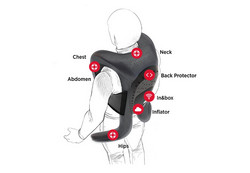How high tech start-ups are shaking up protective clothing
Combining the latest advances in sensor and wireless technology with comfortable protective clothing has opened up new partnership possibilities across a range of sectors. Numerous end users stand to benefit from the inclusion of smart technology in protective clothing. For example, while French high-tech start-up IN&MOTION has pioneered intelligent active protection systems for ski racers, the company’s ambitions do not stop at the chair lift. ‘We wanted to investigate whether this technology platform could be used by end users in different markets,’ explains project coordinator Rémi Thomas, co-founder of IN&MOTION. The wearable ski racing air bags developed by the company combine sensor and wireless communication technology that can detect unavoidable falls and inflate in less than 100 milliseconds. User can reactivate the device after deployment, thanks to easy-to-handle consumable parts, making it cost-effective. The innovation will be used at international racing events as of the 2015/2016 ski season. With the right partners, Thomas is confident that the sensor and wireless technology platform can be adjusted to suit motorcyclists. To this end, the recently completed six-month EU-funded INE IAPS project enabled the company to carry out an assessment of the technical challenges and market potential of adapting the airbags to suit the needs of motorcyclists. The risk of fatality or sustaining serious injury in motorcycling accidents remains poorly addressed by existing body protection devices, which have to date failed to adequately integrate sensor and wireless technologies. ‘We spent time discussing these issues with stakeholders, including end users (motorbike riders) and equipment and clothing manufacturers,’ explains Thomas. 'The feedback has been encouraging in that, while there is a clear demand for high tech protection, there is still dissatisfaction with what is currently available on the market.’ This was the first stage of the project; establishing that a viable market exists for advanced protective clothing in the motorcycling sector. The second stage involved analysing technical challenges and seeing what elements of the company’s platform might need to adapted in order to better suit the needs of bikers. Feedback from the industry here has proved very useful. ‘We are a business to business company,’ explains Thomas. ‘To us, it makes sense to combine our technological expertise with the knowledge of companies that understand the market better and know exactly what end users are looking for.’ The next step will be to develop and tweak the technology to suit the specific needs of this sector, and to find partners capable of turning the concept of smart protective motorcycle clothing into a commercial reality. Thomas is also keen to organise simulated tests in order to provide scientific proof of the airbag’s benefits for motorcyclists. This has not been done to date, and would strengthen the commercial positioning of the product when it comes to market. ‘We have identified a number of potential institutions,’ he says. ‘All this, of course, takes time and investment.’ For further information please visit: IN&MOTION website
Countries
France



